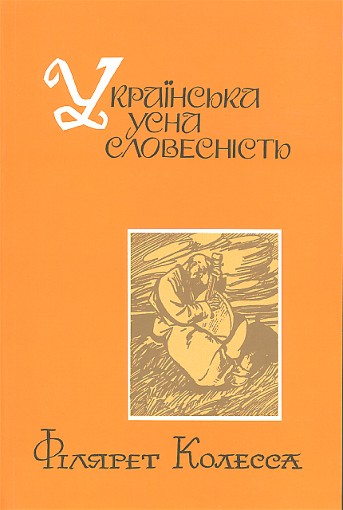Folk oral literature
Folk oral literature. The sum of oral works, both poetry and prose, which are produced usually by anonymous authors and are preserved in the people's memory for a long time by being passed on orally from generation to generation. Ukrainian folk oral literature has its distinctive artistic qualities, its unique poetic devices—metaphors, similes, epithets, and symbolism. The poetic folk literature consists mostly of folk songs, which are subdivided into various genres: ritual songs (songs associated with spring rituals, including vesnianky-hahilky, carols, shchedrivky, Kupalo festival songs, harvest songs, wedding songs and funeral songs), historical songs and dumas, lyrical songs and dance songs. Folk prose can be divided into fables, fairy tales, stories, legends, anecdotes, and others. Poetic-prose folk literature consists of spells, proverbs, sayings, and riddles.
In the 19th century the works of folk oral literature were held to be the products of a collective popular mind. Contemporary folklorists favor the theory that individuals are the creators of the oral tradition. In the basic examples of ancient folk oral literature, however, the words are associated with ritual actions and the verbal text and ritual actions always have a practical, vital purpose. This delimits the creative impulse of the performer. The basic changes that occur in the works of the oral tradition are caused by their dissociation from the original ritual contexts in which they arose. The verbally conveyed image that is divorced from the ritual loses its original practical motivation and either becomes forgotten or else acquires a new motivation, becomes accepted, and begins a new life. Thus, with the coming of Christianity (see Christianization of Ukraine) and the church's rejection of folk literature and folk customs and rites as pagan relics, folk oral literature nevertheless managed to retain its vitality and to absorb the Christian motifs and influences of medieval written literature. Already beginning with the Renaissance and baroque periods there was a constant interchange between oral and written literature. Mixed folklore-literary genres of the baroque appeared—for example, the interludes (intermedii), through which Christmas, Easter, satirical, and parodic verse passed into folklore. The populist movement of the 19th century declared folk oral tradition as the norm and canon for all literature, while literature of the 19th and the beginning of the 20th century systematically grew closer to the folk roots by absorbing certain elements of the language, genres, and content of the folk tradition.
The main genres of traditional folk literature continued to exist under the Soviet regime. After decades in which the Soviets struggled against certain forms of folk oral literature that were viewed as ‘religious vestiges’ and attempted to create artificially a so-called Soviet folklore, the old carols, spring songs, Easter songs, harvest songs, and wedding songs continued to constitute the most important part of the oral literature among the peasantry of the collective farms. They were also promoted by the nationally conscious intelligentsia. The Soviet authorities tried to take advantage of this fact in creating so-called Soviet rites, usually by replacing old song lyrics with new ones dealing mostly with life on the collective farm or in the industrial city. The artificial ‘Soviet folklore’ was restricted to such themes as the glorification of Vladimir Lenin and the Communist Party, the building of communism, the victories of the Soviet Army, and the heroes of labor. A good deal of attention was devoted in Soviet publications on folklore to ‘antireligious folk literature.’ Examples of the very popular folk humor and satire aimed against the regime were never published. The same was true of the rich folk materials that were created in the prisons and concentration camps of the Union of Soviet Socialist Republics.
From 1957 conditions for ethnographic-folklore research became somewhat easier, and some ethnographers and folklorists took advantage of the situation to collect various forms of oral literature, even those that were previously forbidden. Only a small part of the collected materials was published—Pisni Iavdokhy Zuïkhy (The Songs of Yavdokha Zuikha), for example—and most of the materials are preserved in the manuscript holdings and catalogues of the Institute of Fine Arts, Folklore, and Ethnology of the National Academy of Sciences of Ukraine. (See also Folklore.)
BIBLIOGRAPHY
Kolessa, F. Ukraïns’ka usna slovesnist’ (Lviv 1938; 2nd edn, Edmonton 1983)
Petrov, V. Ukraïns’kyi folkl’or (Munich 1948)
Ukraïns’ka narodna poetychna tvorchist’. Radians’kyi period, 2 vols (Kyiv 1958)
Ukraïns’kyi dytiachyi fol’klor (Kyiv 1962)
Ukraïns’ka narodna poetychna tvorchist’ (Kyiv 1965)
Kolasky, J. (ed). Look Comrade—The People Are Laughing ... (Toronto 1972)
Myshanych, S. Usni narodni opovidannia (Kyiv 1986)
Dunaievs’ka, H. Ukraïns’ka narodna kazka (Kyiv 1987)
Bohdan Kravtsiv
[This article originally appeared in the Encyclopedia of Ukraine, vol. 1 (1984).]
